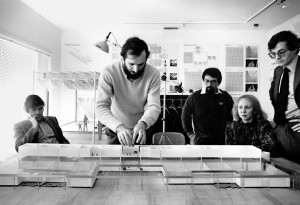
Menil Collection working session. The boss is in the center, Peter Rice on the left, Shunji Ishida, today Piano’s partner, is on the immediate right.
The death of architect Natalie De Blois, who worked on some of SOM’s best projects in the firm’s heyday–Pepsi Cola, Lever House, Union Carbide–has again raised the question of gender and architecture. We are reminded of many unheralded collaborating female architects–Marion Mahoney with Frank Lloyd Wright, Lilly Reich with Mies van der Rohe, Charlotte Perriand with Le Corbusier, Aino with Alvar Aalto–as if there were a plot to suppress giving proper credit to these women. Yet, the architectural profession, while it is a team endeavor, has always asserted the creative role of the individual practitioner. Architects themselves have fostered this useful illusion. Le Corbusier relied heavily on his engineering collaborator, Vladimir Bodiansky, as did Frank Lloyd Wright on Mendel Glickman, another Russian engineer (who worked on both Johnson Wax and Fallingwater). The wonderful light in Kahn’s Kimbell Art Museum and Yale Center for British Art owes a mighty debt to lighting consultant Richard Kelly, and it is surely no coincidence that Kahn’s three masterworks, Kimbell, Richards, and Salk, all involved engineer August Kommendant. Richard Rogers and Renzo Piano get the credit for the Pompidou Center, but the structural details that define that building are the work of Arup’s Peter Rice, who also collaborated on the Menil Collection. Junior associates have always contributed to their employers’ fame, and when this contribution feels unrewarded, they often break away to strike out on their own, as Michael Hopkins and Ken Shuttleworth did from Norman Foster, Bing Thom from Arthur Erickson, and Adrian Smith from SOM. This has always been the pattern among architects. Although art historians are mistaken in approaching architecture as if it were a personal, individual endeavor, I don’t think that crediting the individual is altogether wrong. The master architect is somewhat like a film director, who marshals a large team, and relies on many collaborators; the cameraman, the editor, the sound man, who all make crucial contributions. Yet, in the end, someone must make the final cut. That is why it is correct to refer to the oeuvre of a great director, just as it is right to see the hand (and eye) of an individual architect in his creations, no matter how many others are involved.

